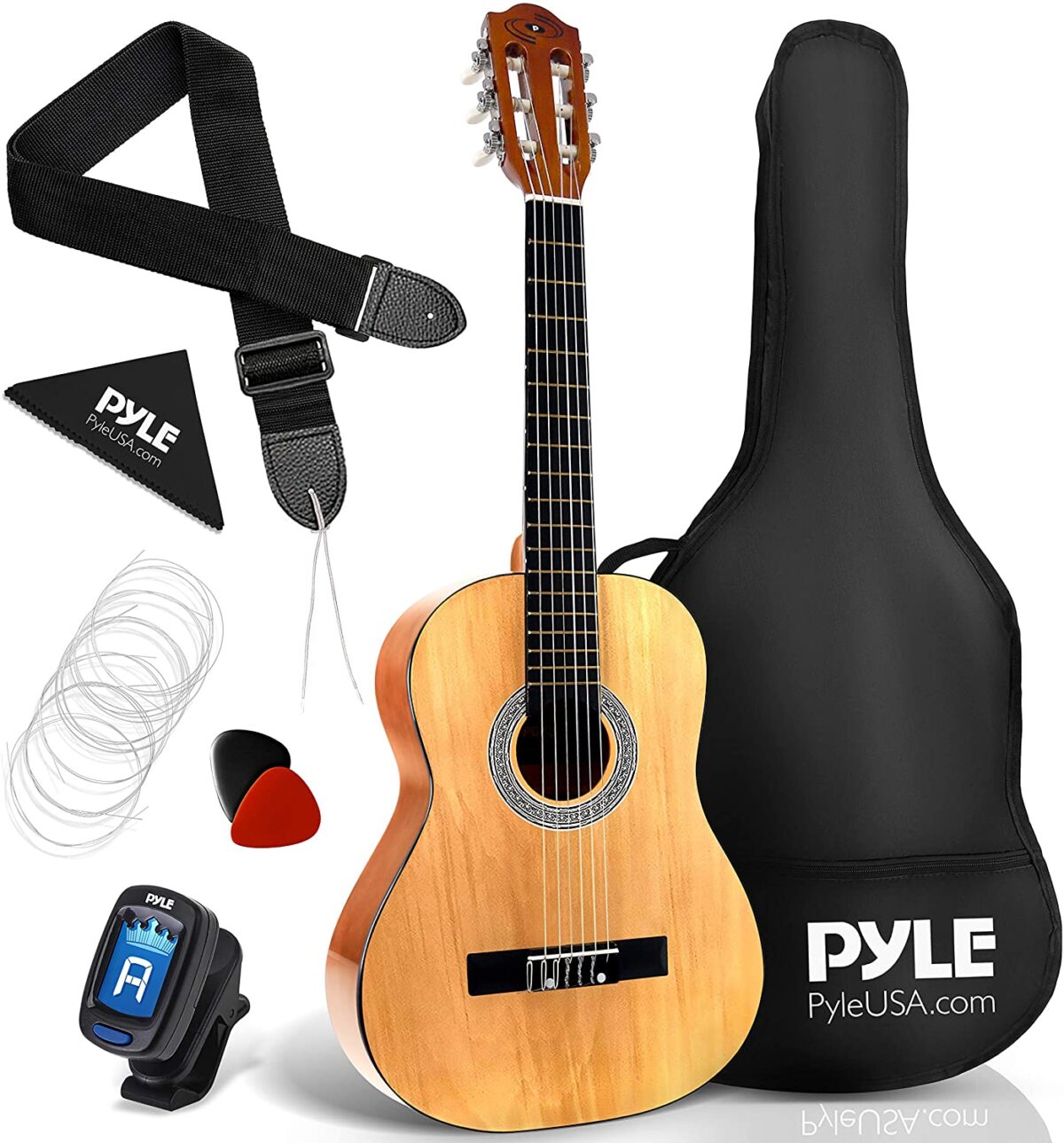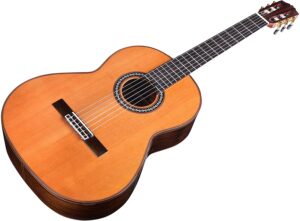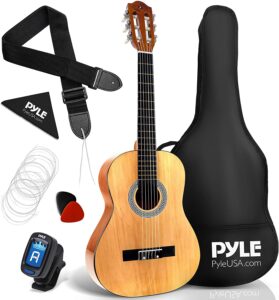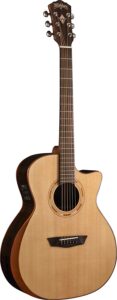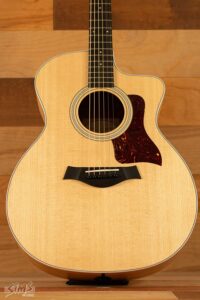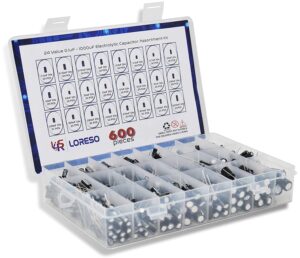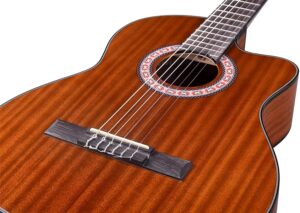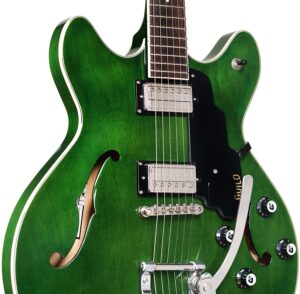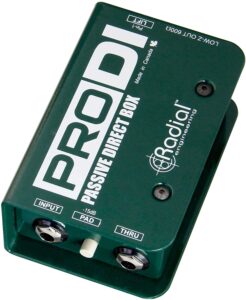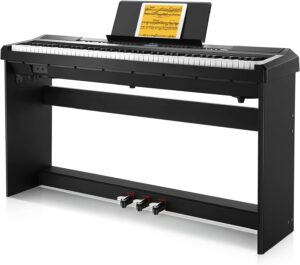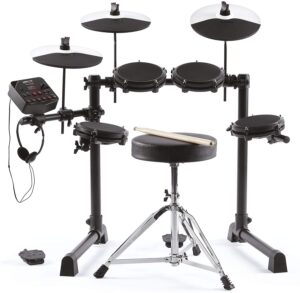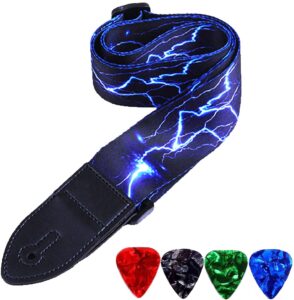Musicians are often very picky about their personal instruments. Some prefer a certain style or design, while others may have a thing for select brands. An acoustic guitar is one of the most popular fretted string instruments, ideal for beginners and experts alike. Your choice of the acoustic guitar will determine your eventual interest in music, and it makes sense to pick one that will stand the test of time. Well-built and maintained acoustic guitars can last a lifetime. In this post, we are sharing some of the best mid-range acoustic guitar options, with a guide on how to choose one.
| IMAGE | PRODUCT | DETAILS | ||
|---|---|---|---|---|
|
Our Top Pick
|
Our Top Pick |
Fender Tim Armstrong 10th Anniversary Hellcat Acoustic Guitar |
|
Check Latest Price |
|
2
|
2 |
Cordoba C10 Parlor Small Body, All-Solid Woods, Acoustic Nylon String Guitar |
|
Check Latest Price |
|
3
|
3 |
Pyle 36” Classical Acoustic Guitar |
|
Check Latest Price |
|
4
|
4 |
Other 6 String Acoustic-Electric Guitar |
|
Check Latest Price |
|
5
|
5 |
Taylor 214ce Grand Auditorium |
|
Check Latest Price |
Reviewing top five Best Mid-Range Acoustic Guitar
This is the special 10th-anniversary edition of the famed Hellcat Acoustic Guitar from Fender. The brand has been synonymous with acoustic guitars, but this particular product is an ode to Tim Armstrong. In fact, the modeling has been done the instrument owned by Tim Armstrong in the 1960s. Besides the design, the model comes with an amazing build, featuring a solid spruce top and Tim’s signature Hellcat inlay. If you are looking for a guitar that scores high on looks and value, go for this one.
What We Liked
- Tim’s signature Hellcat inlay
- Spruce top
- Fender’s unique onboard electronics
- Gold hardware
- Special edition
- Glossy finish
- Made in the USA
What We Didn’t Like
- Absolutely none!
If you are looking for a Parlor size guitar, this one from Cordoba Guitars should fit the bill. This is a design meant for beginners, people with small hands, and kids. The smaller size gives more precise control on the fretboard, and the C10 Parlor is a handmade guitar boasting of traditional Spanish construction. It features a Canadian cedar top with Indian rosewood back and sides.
What We Liked
- Budget-friendly Parlor size guitar
- Spanish construction techniques
- Handmade
- High-quality Canadian cedar top
- Ideal for beginners
What We Didn’t Like
- May not work for everyone because of the size
We have picked this classical acoustic guitar from Pyle sheerly for beginners. This is a junior scale 6 string guitar, which makes it ideal for beginners and kids. The package includes a very durable gig bag case with spare strings and a pitch pipe tuner. The guitar features a handcrafted construction, with the body made of linden wood, while the fretboard is crafted from dyed maple wood. Being a ready kit, this is just ideal for beginners.
What We Liked
- Budget-friendly acoustic guitar kit
- Great for kids and beginners
- 36-inch length
- Linden wood top
What We Didn’t Like
- Nylon strings may not work for everyone
This is a perfect guitar from the Washburn comfort 20 Series, featuring a Sitka spruce top along with Paul Ferro back & sides. For those looking for an acoustic-electric guitar in budget, this one could be a perfect pick. The guitar features an armrest bevel, which adds to the playing experience. Thanks to premium Fishman electronics, this could be an ideal acoustic guitar for stage performances.
What We Liked
- Premium finish
- Solid Sitka spruce top
- Mahogany binding and beveled armrest
- Fishman electronics
- Good pick for comfort playing
What We Didn’t Like
- Slightly expensive
This is the Taylor Grand Auditorium Cutaway guitar that comes with Venetian top wood, with back and sides made of solid Sitka Spruce. Taylor is one of the more reliable brands in the market, and they have acoustic guitars for every need and budget. If you don’t mind going for a slightly lighter model, we promise that this Taylor model wouldn’t disappoint.
What We Liked
- Taylor’s brand value
- Solid Sitka Spruce sides and back
- Venetian top wood
What We Didn’t Like
- Feels lighter than the description
How to shop for mid-range acoustic guitars?
Maintaining your acoustic guitar is fundamental for keep it in great playing condition, protect its sound quality, and broaden its life expectancy. Here are a few hints on how to maintain your acoustic guitar:
1. Keep It Clean:
– Wipe down your guitar with a perfect, dry, and build up free fabric after each playing meeting. This assists eliminate with perspiring, oil, and soil that can gather on the guitar’s surface.
2. Change Strings Regularly:
– Strings can become consumed, lose their tone, or break over the long haul. Change your strings on a case by case basis. The recurrence of string changes really relies on how frequently you play, your playing style, and the kind of strings you use.
3. Store Your Guitar Properly:
– At the point when not being used, store your acoustic guitar in a hardshell case or a very much cushioned gig sack. This safeguards it from dust, stickiness, temperature variances, and actual harm.
4. Monitor Moistness Levels:
– Acoustic guitars are delicate to changes in moistness, which can prompt breaking, distorting, or other harm. Utilize a guitar humidifier to maintain the right degree of dampness, particularly during dry or cold weather months. Keep the relative dampness between 45-55%.
5. Regularly Investigate the Neck:
– Actually look at the neck for appropriate alleviation (the slight bow in the neck). In the event that you notice changes in the neck curve or activity level, counsel an expert professional or luthier to change the bracket bar if vital.
6. Clean the Fretboard:
– When the fretboard gets filthy, utilize a delicate material or a particular fretboard cleaner to clean it. If your fretboard is made of rosewood or black, you can sometimes utilize lemon oil or a particular fretboard conditioner to saturate the wood, yet try not to utilize unnecessary sums.
7. Protect the Finish:
– Be careful to try not to knock or scratching the guitar’s completion. Utilize a clean intended for guitars to maintain its sparkle, and apply it sparingly.
8. Regularly Review Hardware:
– Check the tuning machines, tie buttons, and other equipment for any free parts. Fix screws or nuts depending on the situation.
9. Monitor the Bridge:
– Watch out for the extension for any lifting or partition from the guitar’s top. On the off chance that you notice any issues, counsel an expert for fix.
10. Check for Breaks and Underlying Issues:
– Intermittently examine your guitar for any noticeable harm, breaks, free supports, or other primary issues. On the off chance that you see any issues, have them tended to by a certified guitar specialist or luthier.
11. Protect from Outrageous Temperatures:
– Try not to open your guitar to outrageous intensity or cool, as quick temperature changes can harm the instrument.
12. Play Gently:
– Be aware of your playing style to keep away from extreme mileage on your guitar. Play with a lighter touch to broaden the existence of the strings and limit weight on the guitar’s construction.
Customary support and legitimate consideration are fundamental to guarantee the life span and ideal execution of your acoustic guitar. In the event that you’re unsure about any part of maintaining your guitar or on the other hand in the event that you notice any issues that need fix, talk with an expert guitar specialist or luthier. They can give master direction and guarantee your instrument stays in magnificent playing condition.
How to Play Acoustic Guitar?
Playing the acoustic guitar is a fulfilling and pleasant melodic experience. Here are the moves toward assist you with getting everything rolling:
1. Get the Right Guitar:
– Pick the right acoustic guitar for your necessities and spending plan. Acoustic guitars come in different body sizes, shapes, and tonewoods, each with its own sound qualities. Evaluate various guitars at a music store to track down one that suits your inclinations.
2. Tune Your Guitar:
– Before you begin playing, ensure your guitar is in order. You can utilize an electronic tuner or tune it by ear. The standard tuning for a 6-string acoustic guitar is E, A, D, G, B, and E from the most reduced (sixth) string to the most noteworthy (first) string.
3. Learn Fundamental Chords:
– Start with open harmonies, like C, D, G, E, and A. These harmonies are fundamental for playing many melodies. Work on exchanging between these harmonies easily.
4. Practice Playing Patterns:
– Foster your playing strategy by rehearsing different playing designs. Begin with straightforward downstrokes and upstrokes and continuously add more complicated designs as you progress.
5. Fingerpicking Technique:
– Assuming you’re keen on fingerpicking, gain proficiency with the nuts and bolts of fingerstyle playing. Begin with straightforward examples and move gradually up to additional unpredictable game plans.
6. Learn Songs:
– Pick melodies you like and figure out how to play them. Numerous melodies utilize a blend of fundamental harmonies and playing designs, making them ideal for fledglings.
7. Practice Scales:
– Learning scales, for example, the major and minor scopes, will assist you with understanding the guitar’s fretboard and empower you to make your tunes and performances.
8. Work on Barre Chords:
– As you advance, practice barre harmonies, which include utilizing a solitary finger to cover every one of the strings at a particular fret. These harmonies permit you to play more intricate and flexible harmony movements.
9. Use a Metronome:
– Practice with a metronome to work on your timing and musicality. Steady mood is significant for playing great.
10. Learn Guitar Tabs:
– Guitar sheet music (tabs) is a visual portrayal of guitar music. It’s a useful method for learning tunes and songs, particularly on the off chance that you can’t peruse printed music.
Recall that figuring out how to play the acoustic guitar is an excursion that requires some investment and devotion. Show restraint toward yourself, and partake during the time spent making music. As you progress, you’ll think that it is seriously fulfilling and satisfying.
How to shop for mid-range acoustic guitars?
1. The very first thing that you need to decide is the budget. Even if you are a beginner, it makes sense to find an acoustic guitar with a decent build quality, or else you wouldn’t enjoy playing the instrument. At the least, consider spending $300 or more.
2. A big factor that influences the prices of acoustic guitars is the top. Solid wood top, such as spruce, can add to the cost of the guitar, while laminate ones are cheaper. You can easily distinguish between the materials by weight and overall feel. Laminate tops feel glossier and don’t add much to the weight of the guitar.
3. Check for the brand. While it is okay to go local with your first acoustic guitar, we would highly recommend that you consider the brand too. Yamaha, Fender, Taylor, Washburn are some of the popular choices. If you don’t mind paying a tad more, check for Martin guitars.
4. Choosing between acoustic-electric and acoustic guitars. This may not be a big deal for beginners, but you can plug in an amplifier to maximize sound from acoustic-electric guitars. For simple acoustic guitars, you may need a PA system.
5. Check other details. From the hardware to strings and overall build quality, you have to check all other components of the guitar to choose one. Coming to the finish of the guitar, it is more of a personal choice, but remember that a guitar with too much finish will clog the wood fibers.
If you are learning and want to focus on the music alone, go for natural finishes in acoustic guitars when possible. A good guitar from a known brand is your best pick, and you can always check various series of acoustic guitars that are available from makers we mentioned above.
Frequently Asked Questions
What does a mid-range acoustic guitar look like?
What advantages does a midrange acoustic guitar have over a cheap model?
Do any particular manufacturers excel at producing mid-priced acoustic guitars?
What are different body styles?
What are some of the best materials for acoustic guitars?
If you want to get a solid top acoustic guitar, your best options include spruce, cedar, mahogany, and maple. Rosewood is also a popular choice. An acoustic guitar is an investment, and a solid wood top does feel different when it comes to sound and tones. Solid Sitka Spruce tops are often preferred by many acoustic guitar enthusiasts.
Does the string material matter?
Conclusion
Choosing between acoustic guitars is a lot easier if you focus on the basic design, build, brand, and materials used. There are also parlor-sized guitars, which are ideal for those who want to learn and have better control on the guitar. If you have a kid at home, consider going for a parlor guitar, and you can easily choose one of the acoustic guitar sets mentioned in this post as a perfect wholesome gift.

